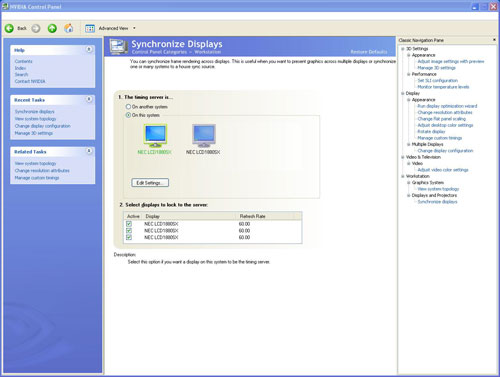| NVIDIA frame synchronizing technology involves two main processes:
- Frame lock and swap—synchronizing applications across multiple displays or windows
- Genlock—synchronizing one or more systems to a common sync source
Frame Lock and Swap
Proper synchronization of an application that runs on multiple displays involves frame lock synchronization and swap synchronization.
Frame Lock
Frame lock uses hardware to synchronize the frames on each display and to redraw to multiple displays at the same time. When an application is displayed across multiple monitors, frame-locked systems help maintain image continuity to create a virtual canvas. Frame lock is especially critical for stereo viewing, where the left and right fields must be in sync across all displays.
As with frame sync, frame locking several systems requires that the systems be connected, with the sync signal fed from the timing server to the other systems in the group. A network of frame-locked systems can be synchronized by connecting the timing server to an external synchronization source.
Swap (Swap Sync)
Swap sync refers to synchronizing buffer swaps from multiple application windows. This includes the ability to have frame-accurate synchronized displays. Using swap sync, applications running on multiple systems can synchronize the application buffer swaps between all the systems. Swap sync requires the graphics systems be frame locked, plus the buffers be swapped at the same time. The absence of swap sync introduces visual continuities that detract from the overall quality of the display.
The NVIDIA solution lets the user or application instruct one system to be the timing server, while the remaining systems automatically default to “client” mode.
Swap-sync signaling is implemented in the NVIDIA Quadro hardware, so latency is minimized. This ensures that all the graphics cards deployed in the solution are synchronized to the same pixel rate and that the output pixels are in complete lock-step.
|






